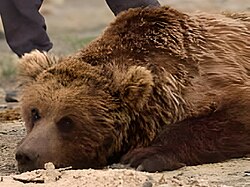Gobi bear
Subspecies of carnivore From Wikipedia, the free encyclopedia
The Gobi bear (Ursus arctos gobiensis), known in Mongolian as the Mazaalai (Мазаалай), is a subspecies of the brown bear (Ursus arctos) that is found in the Gobi Desert of Mongolia.[2] It is listed as critically endangered by the Mongolian Redbook of Endangered Species and by IUCN standards.[3] Currently, there are only 51 (95% CI: 40 - 51) bears left in the Mongolian Gobi Desert; through long-term genetic monitoring it is known that the population is relatively stable, however, the sex ratio is highly skewed towards males.[4] Gobi bears are separated by enough distance from other brown bear populations to achieve reproductive isolation. In 1959, hunting of the animal was prohibited in order to preserve the dying subspecies.[5]
| Gobi bear | |
|---|---|
 | |
| Scientific classification | |
| Domain: | Eukaryota |
| Kingdom: | Animalia |
| Phylum: | Chordata |
| Class: | Mammalia |
| Order: | Carnivora |
| Family: | Ursidae |
| Genus: | Ursus |
| Species: | |
| Subspecies: | U. a. gobiensis |
| Trinomial name | |
| Ursus arctos gobiensis Sokolov & Orlov, 1920 | |

Description
Summarize
Perspective
Gobi bears mainly eat roots, berries, and other plants, sometimes rodents; there is no evidence that they prey on large mammals. Gobi bears are typically solitary, except for the periods of mating season and when one has to raise cubs. In general, the bears in the Gobi demonstrate seasonal behaviors: foraging is done during the warmer months, while hibernation with reduced activity is done during the harsh winters. Habitat loss, climate change, and human encroachment have generally affected the ecology of the Gobi bear. The diet of a Gobi Bear is only about 8% animal protein.[6] Small compared to other brown bear subspecies, adult males weigh about 96.0–138.0 kg (211.6–304.2 lb) and females about 51.0–78.0 kg (112.4–172.0 lb).[7] Gobi bears are the only bears that have evolved and adapted to living in such extreme hot desert climates.[4] They have a very low genetic diversity,[8][9] among the lowest ever observed in any subspecies of brown bear, as it is one of the smallest and most isolated brown bear populations in the world.[4] Levels of genetic diversity similar to the Gobi bears have been reported only in a small population of brown bears in the Pyrenees Mountains on the border of Spain and France. The low genetic diversity is the result of Gobi bears having a highly skewed sex ratio of males to females.[8] In addition, research has shown there is a low number of alleles per locus in their DNA. This means that Gobi bear DNA is fragile and therefore affects their reproduction.[4]
Conservation and research
Summarize
Perspective
The Gobi bear population is restricted to 23,600 km2 (9,100 sq mi) in areas that are in close proximity to water sources (Reynolds et al. 2010, Luvsamjamba et al. 2016), and the population is isolated from other populations by inhospitable low elevation deserts, pastoral activities, and human settlements.[4] A conservation measure for the Gobi Bear has been in place since 1985, which is a supplemental feeding program involving pellets containing wheat (Triticum aestivum), corn (Zea mays), carrots (Daucus carota sativus), and turnips (Brassica rapa) which are provided in spring and autumn at feeders located near selected waterholes throughout the Great Gobi Strictly Protected Area (GGSPA).[6][8][4]
Previously, the Gobi brown bear has sometimes been classified as being in the same subspecies as the Tibetan blue bear based on geography or the Himalayan brown bear[10] based on mitochondrial short fragments studies. However, the recent whole-genome and larger mitochondrial DNA analyses revealed that Gobi and Himalayan brown bears are already diverged lineages and have a shared ancestry, the oldest lineage of all other brown bears.[2][9] A 263 base-pair segment of the mitochondrial DNA was sequenced for 3 bears and a single haplotype was gained. This haplotype was closely related to brown bear haplotypes from Pakistan. The low levels of genetic diversity supports the idea that the Gobi bears are isolated from other brown bear populations.[11]
A total of 51 bears were found during 2007–2018 based on the systematic sampling, but the population size is relatively stable 31 (95% CI: 29-38) based on the long-term study.
References
Further reading
Wikiwand - on
Seamless Wikipedia browsing. On steroids.

